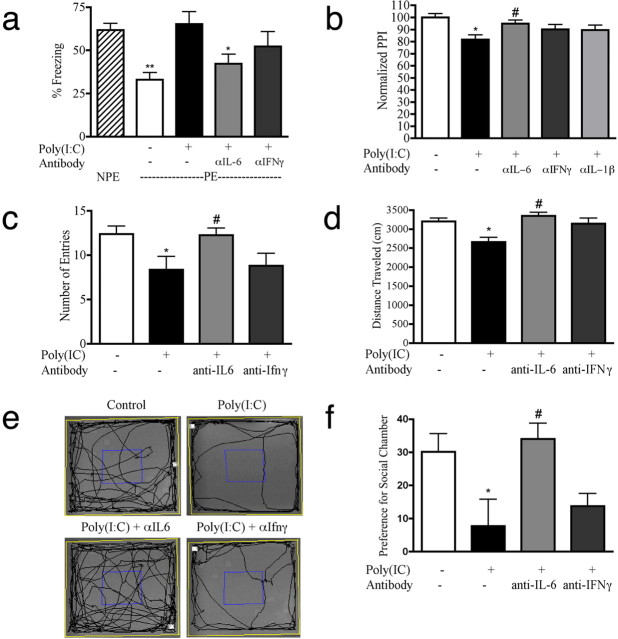Figure 2.
Abnormal behavior in MIA offspring is prevented by maternal treatment with anti-IL-6 antibody. a, Offspring of mice treated with poly(I:C) lack LI. Coinjection of anti-IL-6 with poly(I:C) restores significant LI, whereas coinjection of anti-IFNγ does not (F(4,132) = 7.566; p < 0.0001). **p < 0.001 versus NPE; *p < 0.01 versus NPE. b, Compared with controls, the offspring of mice treated with poly(I:C) show a PPI deficit at a prepulse level of 85 dB. Coinjection with anti-IL-6 prevents this deficit. The PPI of offspring of mice given coinjections of poly(I:C) and anti-IFNγ or anti-IL-1β are not significantly different from control or poly(I:C) (F(4,270) = 4.195; p < 0.005). *p < 0.001 versus control; #p < 0.05 versus poly(I:C). c, d, In the open-field test, offspring of mice treated with poly(I:C) make fewer entries than controls into the center (c) and travel less total distance (d). Offspring of mice given coinjections of anti-IL-6 enter the center as often as control mice [F(3,123) = 3.703; p < 0.05; *p < 0.05 vs control; #p < 0.05 vs poly(I:C)] and move a similar total distance [F(3,123) = 6.666; p < 0.0005; *p < 0.01 vs control; #p < 0.001 vs poly(I:C)]. Offspring of mice given coinjections of poly(I:C) and anti-IFNγ are not significantly different from controls or poly(I:C). e, Tracks recorded during the open-field session demonstrate increased thigmotaxis in offspring of poly(I:C)-treated mice compared with offspring of mice given coinjections of an IL-6 antibody. f, In the social interaction test, control mice show a strong preference for the social chamber [defined as (percentage of time in social chamber) − (percentage of time in opposite chamber)], whereas the offspring of poly(I:C)-treated mice show no such preference. Again, the deficit is corrected by maternal administration of IL-6 antibody (F(3,50) = 4.244; p < 0.01). *p < 0.05 versus control; #p < 0.05 versus poly(I:C).

